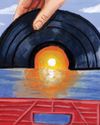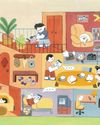
ONE OCTOBER DAY a few years ago, astrophysicist Sean Dougherty opened an email to find an astonishing image. On his screen was a sunlike star located about 450 light-years away. Rendered in unprecedented detail, the bright yellow circle was surrounded by fuzzy rings darkening from orange to red with gaps interspersed in between. The whole thing looked like a hot element on an electric stove.
What Dougherty was seeing, for the first time in such fine resolution, was evidence of new planets forming.
The image had been created thousands of kilometres away, in Chile, by the largest ground-based telescope array in the world. At the time, the observatory hadn’t been fully completed, and astronomers were just starting to grasp the worlds it would open up to them. For Dougherty, who was then working as the director of a small observatory in Kaleden, BC, just south of Okanagan Lake, the image of the star, which is called HL-Tau, was almost too beautiful to believe. It hinted at what the solar system looked like in its infancy, more than four billion years ago. And, because it showed the dark gaps that astronomers had predicted in their calculations, it was a landmark in the history of astronomy.
This story is from the July/August 2020 edition of The Walrus.
Start your 7-day Magzter GOLD free trial to access thousands of curated premium stories, and 8,500+ magazines and newspapers.
Already a subscriber ? Sign In
This story is from the July/August 2020 edition of The Walrus.
Start your 7-day Magzter GOLD free trial to access thousands of curated premium stories, and 8,500+ magazines and newspapers.
Already a subscriber? Sign In

Invisible Lives
Without immigration status, Canada's undocumented youth stay in the shadows

My Guilty Pleasure
"The late nights are mine alone, and I'll spend them however I damn well please"

Vaclav Smil Is Fed Up
The acclaimed environmental scientist is criticizing climate activists, shunning media, and stepping back just when we need him most

It's Time for a Birth Control Revolution
What the pill teaches us about the failure - and future - of women's health care

Would You Watch a Play about Hydro Electricity?
How documentary theatre struck a chord in Quebec

Still Spinning
One record chain has bet big on a new appetite for physical media

Just So You Know, I Love My Mother
In many ways, multi-generational living makes sense. But that doesn't make it easy

Art of the Steal
Why are plundered African artifacts still in Western museums?

Canada in the Middle
What role can we play in easing the war in Gaza?
Canadian Multiculturalism: A Work in Progress
As we mark fifty years since the adoption of Canada’s federal multiculturalism policy, human rights advocate AMIRA ELGHAWABY celebrates its merits and reflects on the work that is yet to be done when it comes to inclusion, acceptance, and fighting systemic racism in our country.